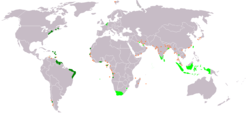
Back Keurajeuën Beulanda ACE Nederlandse Ryk Afrikaans الإمبراطورية الهولندية Arabic هولند ایمپیراتورلوغو AZB Калоніі Нідэрландаў Byelorussian ওলন্দাজ ঔপনিবেশিক সাম্রাজ্য Bengali/Bangla Impalaeriezh trevadennel an Izelvroioù Breton Imperi neerlandès Catalan Nizozemská koloniální říše Czech Niederländische Kolonien German
This article needs additional citations for verification. (April 2023) |
Dutch colonial empire Nederlandse koloniale rijk (Dutch) | |
|---|---|
| 1602–1975[1] | |
 Map marking territories that at some point were Dutch holdings
Territories administered by or originating from territories administered by the Dutch East India Company Territories administered by or originating from territories administered by the Dutch West India Company Tiny orange squares indicate smaller trading posts, the so-called handelsposten. | |
| History | |
| 1595–1600 | |
• Company rule in the East Indies started | 1602 |
| 1621 | |
| 1598–1663 | |
| 1814 | |
| 1830 | |
| 1940–1945 | |
• Indonesia independence | 1949 |
| 1949–1962 | |
| 1954 | |
• Suriname independence | 1975[1] |
The Dutch colonial empire (Dutch: Nederlandse koloniale rijk) comprised the overseas territories and trading posts controlled and administered by Dutch chartered companies—mainly the Dutch East India Company and the Dutch West India Company—and subsequently by the Dutch Republic (1581–1795), and by the modern Kingdom of the Netherlands after 1815.[2]
By Jan van Riebeeck's landing at the Cape of Good Hope in 1652, it had colonial provinces in eastern North America, the Caribbean, South America (Suriname and Brazil), Africa (on the Gold Coast and at the Cape), mainland India, Sri Lanka, Indonesia and Taiwan. It also chartered new lands of Australia and New Zealand.
It was initially a trade-based system which derived most of its influence from merchant enterprise and from Dutch control of international maritime shipping routes through strategically placed outposts, rather than from expansive territorial ventures.[3][2]
Because small European trading-companies often lacked the capital or the manpower for large-scale operations, the States General chartered larger organisations—the Dutch West India Company and the Dutch East India Company—in the early seventeenth century, based on England's model that was slowly developed a century before.[4] The companies' domination of global commerce contributed greatly to a commercial revolution and a cultural flowering in the Netherlands of the 17th century, known as the Dutch Golden Age.[5]
In their search for new trade passages between Asia and Europe, Dutch navigators explored and charted distant regions such as Australia, New Zealand, Tasmania, and parts of the eastern coast of North America.[6] During the period of proto-industrialization, the empire received 50% of textiles and 80% of silks import from the India's Mughal Empire, chiefly from its most developed region known as Bengal Subah.[7][8][9][10]
In the 18th century, the Dutch colonial empire began to decline as a result of being overwhelmed from the Fourth Anglo-Dutch War of 1780–1784, in which the Dutch Republic lost a number of its colonial possessions and trade monopolies to the British Empire and French colonial empire, along with the conquest of the Mughal Bengal at the Battle of Plassey by the British East India Company.[11][12][13] Nevertheless, major portions of the empire survived until the advent of global decolonisation following World War II, namely the East Indies and Dutch Guiana.[14] Three former colonial territories in the West Indies islands around the Caribbean Sea—Aruba, Curaçao, and Sint Maarten—remain as constituent countries represented within the Kingdom of the Netherlands.[14]
- ^ "Dutch empire". Oxford Reference. doi:10.1093/acref/9780191737565.timeline.0001 (inactive 1 November 2024). Retrieved 4 May 2024.
{{cite web}}: CS1 maint: DOI inactive as of November 2024 (link) - ^ a b Israel, Jonathan (2003). Empires and Entrepots: Dutch, the Spanish Monarchy and the Jews, 1585–1713. London: Hambledon Press. pp. x–xii. ISBN 978-1852850227.
- ^ Ward, Kerry (2009). Networks of Empire: Forced Migration in the Dutch East India Company. Cambridge: Cambridge University Press. pp. 322–342. ISBN 978-0-521-88586-7.
- ^ Hunt, John (2005). Campbell, Heather-Ann (ed.). Dutch South Africa: Early Settlers at the Cape, 1652–1708. Philadelphia: University of Pennsylvania Press. pp. 2–13. ISBN 978-1904744955.
- ^ Hsin-Hui, Chiu (2008). The Colonial 'civilizing Process' in Dutch Formosa: 1624–1662. Leiden: Tuta Sub Aegide Pallas. pp. 3–8. ISBN 978-9004165076.
- ^ Fisher, Ann Richmond (2007). Explorers of the New World Time Line. Dayton, Ohio: Teaching & Learning Company. pp. 53–59. ISBN 978-1429113175.
- ^ Junie T. Tong (2016). Finance and Society in 21st Century China: Chinese Culture Versus Western Markets. CRC Press. p. 151. ISBN 978-1-317-13522-7.
- ^ John L. Esposito, ed. (2004). The Islamic World: Past and Present. Vol. 1: Abba – Hist. Oxford University Press. p. 174. ISBN 978-0-19-516520-3.
- ^ Nanda, J. N (2005). Bengal: the unique state. Concept Publishing Company. p. 10. 2005. ISBN 978-81-8069-149-2.
Bengal [...] was rich in the production and export of grain, salt, fruit, maize, liquors and wines, precious metals and ornaments besides the output of its handlooms in silk and cotton. Europe referred to Bengal as the richest country to trade with.
- ^ Om Prakash, "Empire, Mughal Archived 18 November 2022 at the Wayback Machine", History of World Trade Since 1450, edited by John J. McCusker, vol. 1, Macmillan Reference USA, 2006, pp. 237–240, World History in Context. Retrieved 3 August 2017
- ^ Indrajit Ray (2011). Bengal Industries and the British Industrial Revolution (1757–1857). Routledge. pp. 57, 90, 174. ISBN 978-1-136-82552-1.
- ^ Hobkirk, Michael (1992). Land, Sea or Air?: Military Priorities- Historical Choices. Basingstoke: Palgrave-Macmillan. pp. 77–80. ISBN 978-0312074937.
- ^ Dalio, Ray. "The Big Cycles of the Dutch and British Empires and Their Currencies" Archived 1 October 2020 at the Wayback Machine, LinkedIn, 21 May 2020
- ^ a b Jones, Guno (2014). Essed, Philomena; Hoving, Isabel (eds.). Dutch Racism. Amsterdam: Rodopi B.V. pp. 315–316. ISBN 978-9042037588.

